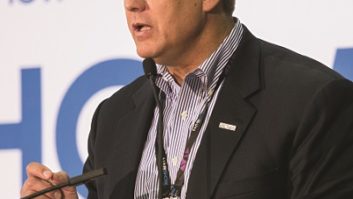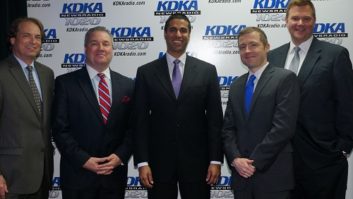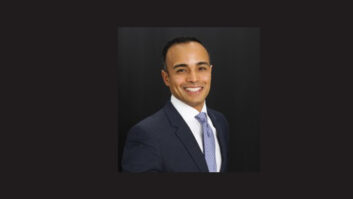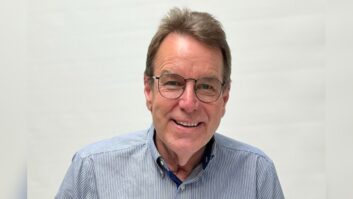
BRYAN-COLLEGE STATION, Texas — Ben Downs is vice president and general manager of Bryan Broadcasting, a radio group of five stations he also owns with business partner and company President Bill Hicks. Downs is in his third term as a member of the NAB Radio Board and is an advocate for technological improvements for AM.
Of Bryan Broadcasting’s five stations, four are AMs. The FM broadcasts in HD Radio and also has an associated multicast channel. The company employs some 60 people.
Downs believes in having fun in radio. He’s been his town’s Santa for nearly 30 years. “I have staff who, when they were children, told me what they wanted for Christmas,” he says.
The chairman of NAB’s AM Task Force got his start in radio at the age of 14 in 1968 as a part-time announcer in Hope, Ark. He changed transmitter tubes and worked on cart machines. He says he still tweaks with transmitters because he “likes to touch the gadgets.” Downs will moderate an HD Radio panel at this month’s Radio Show in Dallas.
The Texas A&M graduate recently spoke with Radio World News Editor/Washington Bureau Chief Leslie Stimson about issues affecting radio, especially improvements for the AM band.
RW: How would you describe the economic health of commercial radio as we ease into fall? Were smaller radio markets affected differently during the downturn?
Downs: Things are really different at the small radio market level. I think we’re Market No. 190 or so, and one of the advantages of that is that local advertisers can actually afford to advertise on our stations. And local selling, as anybody will tell you, is really more relational selling. When you’re dealing with national accounts, it doesn’t matter what you’ve done to benefit the advertiser. Whoever the latest media buyer is will toss you overboard to save a buck. In small towns like this a national account really has no idea if you’ve gone the extra mile for a local franchise. But the people in the town know that you bought lunch for a work crew or they know that maybe you helped them out with a public service event that they had going on at their restaurant.
RW: So you may not have experienced the same degree of economic turmoil …
Downs: We didn’t. Since 2009 we’ve shown fairly good increases year-to-year; 2009 was better than 2008 … 2010 was better than 2009. We’re blessed … Don’t get me wrong; we don’t take it for granted. But if, for example, the local car dealer is a member of the Rotary Club, and the Rotary has a special event you supported with free PSAs, they’re going to remember that when they place their local advertising buys.
RW: In the face of more competition from Pandora and other Web-based audio services in the car, what does radio need to do in order to remain relevant in the digital dashboard?
Downs: It’s about content. Katy Perry sounds the same on my radio station as it does on Pandora as it does on a station in San Diego. But what matters the most is how you wrap around the music. If that listener only wants to listen to music and doesn’t necessarily want to be engaged in what the locals are talking about, then there are other places to get that. …
[A]re these other platforms important? Yes, they are. I understand you have to be where the listeners are and that’s why we have our streaming apps all in one place, radioaggieland.com.
I understand the dashboard is suddenly cluttered and we have new competitors. And anytime you get a new competitor it’s going to pull some of your listeners away. The fact is that we can change none of that. And so we need to do what we do best, and that is have people in the studios looking out the same window as the listener driving her kids to school, and talk about those things.
You have to be talking about what your locals want to talk about, and let them do some of the talking as well. We’re very interactive. We bring people on board. … [W]e have an extensive texting system back and forth. We use HipCricket’s system. That allows people to text in and we text back.
RW: The host or somebody in the studio is monitoring the texts coming in?
Downs: Yes, during the morning show the morning show hosts see it. In the evening we’re putting interns and part-time employees in there to help with the volume of young people who communicate pretty much just by text these days.
We use it in a big way to engage people for our contesting. When we gave away some tickets to Twilight, we took the 95th texter. Within five minutes we had something like 4,000 texts come through.
RW: Getting back to the dash, is HD Radio a factor in helping radio remain relevant?
Downs: When people are shoving that kind of data down to your dashboard you can do a lot with it. You can really enhance the experience — everything from album art to scrolling lyrics. Right now, if you’re not using HD and you don’t have your RDS turned on, all the listeners are seeing is dial position. And it positions us as somehow technologically inferior to [services like] Aha and Pandora, who have this full-color information about what you’re listening to.
I don’t like being positioned as being inferior. I want people to look at me, and say, “Oh wow. This station is just as cool as Pandora.”
RW: As the operator of a group of mostly AMs, what are your thoughts about helping AM thrive in the face of man-made interference and the increasing noise floor?
Downs: When I’m trying to get my friend’s attention, I say, “Take your basic bedside alarm clock radio and put it in the den tonight. Leave the lights on. Leave the TV on. Turn the radio on, and see how many local radio stations you can pick up. If you can get one or two, congratulations, you’re better than most of us.”
This noise floor that has been allowed to happen is basically rendering AM unlistenable. Every LED sign, every compact florescent light bulb, every flat screen and computer makes it harder to hear us.
It’s a real problem, and it’s quantifiable. As part of the NAB AM Task Force we found a study that did research from 20 years ago to 2007 in both Madrid and Mexico City. To get the same signal-to-noise ratio that we had 20 years ago today, we would have to quadruple the power of AM radio stations, in best case. There are some places they studied in Mexico City where the power would have to be increased 10 times — just to get to the same level of clarity that we had 20 years ago. That’s how much noise is out there.
People don’t understand that they’re hearing the noise; they think the station’s gone away.

Downs has been the local Santa for almost 30 years. ‘I have staff who, when they were children, told me what they wanted for Christmas.’
RW: They’ll just tune to the next station that has a stronger signal.
Downs: It’s a huge problem, and anyone who’s tried to tune an analog dial on their clock radio at night knows that it’s next to impossible to tune in an AM station clearly anymore.
RW: Should there be an across-the-board power increase for AM?
Downs: If we’re going to spend that kind of money on new facilities and new transmitters and new components, I’d rather we spend it on something else. I’d rather we put our money in something that’s not just a temporary fix. Because every time somebody buys a new CFL, that noise floor keeps inching up.
RW: Is there a migration path away from the AM band you see right now?
Downs: There’s not a good way to patch the whole band. Right now there are a lot of things that need to happen. For one thing, we need to be able to say the letters “HD” in your magazine without all the HD haters lighting up their flame machines.
We need the FCC to give us some sort of sign that they would encourage solutions for AM. … Right now all of the oxygen in the room is going to TV spectrum issues — auctioning spectrum and re-packing TV [spectrum]. It’s difficult to get a signal from the FCC that they would like to work with us on this problem. I’m sure they would but there’s only so much time in the day.
There are several migration paths. … My particular favorite is the relocation of AM stations to what’s currently the low VHF TV frequencies.
RW: What about TV Channels 5–6?
Downs: I don’t think the Broadcast Maximization Committee’s proposal will move forward because they proposed all-digital only, no analog. Also it required the few existing TV stations that remain on Channels 5 and 6 to move involuntarily. There are some that cannot move. I think that’s why there’s been so little traction for Broadmax.
However, they did a tremendous amount of heavy engineering lifting there. And they found a home for every AM station that pretty much replicated their coverage area, on the FM band. It was spectacular work. Broadmax may not be the answer, but somewhere, between Channel 2 and Channel 6, there is enough empty spectrum to locate all of the AMs.
Every time some new idea is brought up, there’s always a reason why the current rules wouldn’t permit you to do that. I guess that’s kind of the point. The rules would have to be changed. Between 2 and 6, if I can do my math properly in my head, that’s 150 new FM channels. That’s more than enough room to move the AMs that would want to move. I would ask to set aside part of them for use by AM.
But right now, because the focus is on TV, the people at the FCC want to leave those options open. And I just hope that as the TV spectrum auction plays itself out, it doesn’t lock out this option for AM radio stations. I’m not saying the whole spectrum should be available for FM, but in this world where we can program anything to do anything, set aside some of those frequencies for use by AM stations on the FM band. It clears up our problem with noise, it clears up our problem with getting an AM signal into handsets and it’s an existing technology. No new science would have to be used to do that. Set up the radios, program them to land on X number of channels. Protect the TV stations that remain there 100 percent. There are ways to accommodate both these needs.
RW: What is an example of one of the more immediate things that could help AMs?
Downs: What would help the most number of broadcasters is a rethinking of the rules that considered Class A distance coverage to be a replacement for local coverage. I have a daytimer protecting a station 800 miles away from Bryan-College Station. To expect them to serve our community in morning drive time better than we would really is a fantasy.
Protection for distant stations, critical hours, Class D coverage, all of those things are built upon plans for a totally different era in broadcasting. If you were to tell all the AM daytimers right now that they could stay on the air, maybe with lower power, or something along that line, that’s an infusion of power and strength into the AM band. If you were to tell broadcasters who are operating at night on 25 watts of power that they could match their daytime power at night or in pre-sunrise time, that’s a powerful thing. That would improve local service and, I think, extend the warranty period on AM radio.
RW: Would you consider putting one of your AMs on an FM translator? Or is that not an option for you?
Downs: It isn’t. I just hired a consulting firm to confirm once again that there’s nothing available here for me. And there isn’t. We’re blocked in by regular FM stations and the “no hopping” rule. Even the one or two that are available are a hundred miles away; you can’t really hop them into your market anymore.
I had a translator that was offered for sale to me, in this market, for $700,000 and they would throw in the FM station, which is far out of town. … I think Bryan Broadcasting petitioned at one point to give daytimers priority on getting an FM translator but I don’t think anything ever came of that.
RW: You chair the NAB AM Task Force. The Radio Technology Committee is working on several ideas from the report on technological fixes for AM. What can you tell us about the report?
Downs: The report pretty much covers everything. In the articles that I’ve seen written in the trade press, no one has come up with an idea that wasn’t considered in the report.
I would like for the report to come out soon because I feel like that we need to have an industry discussion, and I think we need to involve as many people as we can in this decision-making process. I can’t speak for the NAB, but the sense I get is that people would like to do more study on some pieces, like the HD-only, in the hope that the further study would make the solutions more clear. Maybe by doing some more research and talking to manufacturers, suddenly an option will pop out and be clear to everyone that this is what should be done.
RW: Ideally, something would make itself clear.
Downs: Yes, and whether that happens or not, no one knows. The NAB has chosen to do more than anyone else has. The NAB’s position is that this is serious stuff and we have to look at it closely before diving into a solution. If we could find a perfect solution that doesn’t require other licensees to move off the band, i.e. the TV guys, then that’s what needs to be done. DRM, streaming, the translator situation, everything has really been looked at, even some blue-sky things that there’s no consumer base for yet.
RW: You hope it would be released soon, meaning?
Downs: I don’t have a timetable. It’s beautiful work and I would like for AM broadcasters to have a chance to take a look at it. It’s very thorough; it’s very well done.
RW: Is releasing the report something the AM Task Force needs to vote on?
Downs: Yes. [No vote or next committee meeting had been scheduled as of mid-August.]
RW: On the potential AM all-digital testing being discussed by the NAB Technology Committee, which reports to the AM Task Force, is it realistic to think that some companies might pick an AM station to turn off the analog for awhile to test all-digital?
Downs: I think so. You wouldn’t need many but we’re hoping there would be somebody who would be willing to do that. … The studies that we’ve seen indicate that the digital-only version is much more robust and goes further and with fewer dropouts than the hybrid version that we’re using now. There’s only been one test, really, done by iBiquity, so there would need to be more study done.
But I think we’re going to find that all-digital is pretty good. It is a better signal that’s less prone to dropouts, mostly immune to impulse noise. The signal is actually strong enough that it might help overcome that problem with the law of physics that keeps AM out of handsets.
Right now you need a longer antenna to pick up AM than you can fit into a handset. There’s the hope that once the testing is started we’ll find that the increased density of the signal will overcome that and, while we may not have a perfect AM antenna in a handset, the ones that we can put in there will work well enough.
RW: AMs must think they’re never going to get a chip in a mobile device. This might be a way of doing that.
Downs: It might be and, of course, migrating to the low VHF band as an FM station, would also get you into mobile devices as well. There’s no new technology needed there.
RW: Would current FM receivers be able to pick that up?
Downs: Probably not, but there would be no new technology required. Right now, in Japan, the FM band is Channel 5 and 6. So the chips are already there to do that much of it. But if you wanted to dodge around and miss grandfathered TV stations or have a certain number of channels set aside, then obviously, there’s a little programming that has to be done, but none of it is new technology. It’s on the shelf.
RW: Switching to streaming, does the performance rights issue affect your company?
Downs: Sure. The only way that streaming works as a business proposition is if it’s not very successful. The more listeners, the more difficult it is to make money. People value listenership online at a much lower rate than they do listenership over-the-air. If I’m successful and if I keep them listening, every time a song changes I owe more money. …
Yet [advertisers] say, “Okay I want to be on the stream. Here’s the average listenership. Here’s what I’ll pay you for it.” It’s very difficult to properly monetize that, at least at my level. … But that said, I do believe once again that you have to be wherever your audience is and we stream everything we’ve got. We stream the talk, music and sports. But it’s more of a promotional and programming decision than it is a financial one.
RW: Have you increased the HD Radio power on your FM?
Downs: Yes, to the extent that we can. We’re awaiting the approval of asymmetrical sidebands. Going from –20 dB to –14 dB … made a really big difference in building penetration and coverage.
RW: Why are you going to raise your HD power asymmetrically?
Downs: On one side we’re clean and green to the full minus 10 dB. On the other sideband we’re protecting an unbuilt construction permit so we have to leave that at minus 14 dB.
RW: Are you planning to implement Artist Experience?
Downs: Yes, we are. I don’t want someone to look at my product and think, “Well this isn’t as good a product as the one right next to it on the dashboard.” If I’m going to be competing with them, I’m going to look as good as them.
RW: You had mentioned you have two engineers. Are they full-time?
Downs: Yes. Chris Dusterhoff is the chiefand Andrew Hicks is his assistant.We’re a little old-school. If you’re going to do radio right and if you’re going to do more than average, then you’re going to need more people. I can’t do it all myself.
RW: How does your company handle engineering purchases?
Downs: We plan what we’re going to [purchase]. We go to the conventions and look at it and touch it. Then we come back and argue about it. Whoever has the best argument gets to win. Truthfully, we go through your magazine as well.
RW: Do you have any equipment purchase plans for this year?
Downs: We have two little Class A FMs that we’re turning on. I’m buying everything needed for a new FM, a contemporary Christian music station here in town. We also were successful in Auction 84, and we’re getting ready to put another FM station in a nearby community on the air.
RW: When will you turn them both on?
Downs: The first one is licensed to Kurten, next to Bryan. The first one will be coming on, I hope, in about a month. I’m getting an antenna pattern study done now. … The one that’s out of town, that will probably be on in about six months.We’ll be streaming them and running HD as well.
RW: How old were you when you started in radio in 1968 in Hope, Ark.?
Downs: I was 14. Governor Mike Huckabee and I worked there [at AM station KXAR] together as high school students.
Later, I came to Texas A&M as an electrical engineering student. Second-year calculus came along and changed my mind. I couldn’t get above a C and I couldn’t take it again.
I can still fix your transmitter, Leslie, but it’s a lot simpler just to put the backup on the air and ship the module back to the manufacturer these days.
RW: Were you wiring studios?
Downs: Yes, and changing 4-400 tubes.
RW: Do you remember the first transmitter you changed a tube for?
Downs: Sure, a Collins 20 V-3. But I can’t remember my blood type.
RW: Do you still do any engineering work?
Downs: I’m still pretty good at fixing transmitters and so if something goes wrong I will not tell our engineers until I’ve had a chance to go play with it. The fact is I did not get into this business to deal with spreadsheets all day long. I do like to touch the gadgets. I do like to do a little on-air stuff when I can.
RW: You’ve been married for 36 years. How did you meet your wife, Lilly?
Downs: We were both engineering students at Texas A&M at the same time. We had dated several times before she actually put together that the guy she was listening to on the radio at night was actually the guy she was dating. She would bring me a quarter-pounder with cheese and fries every day that I was on the air, Monday through Friday, at 6 o’clock. … That was back when people could come in and sit in your studio with you.











